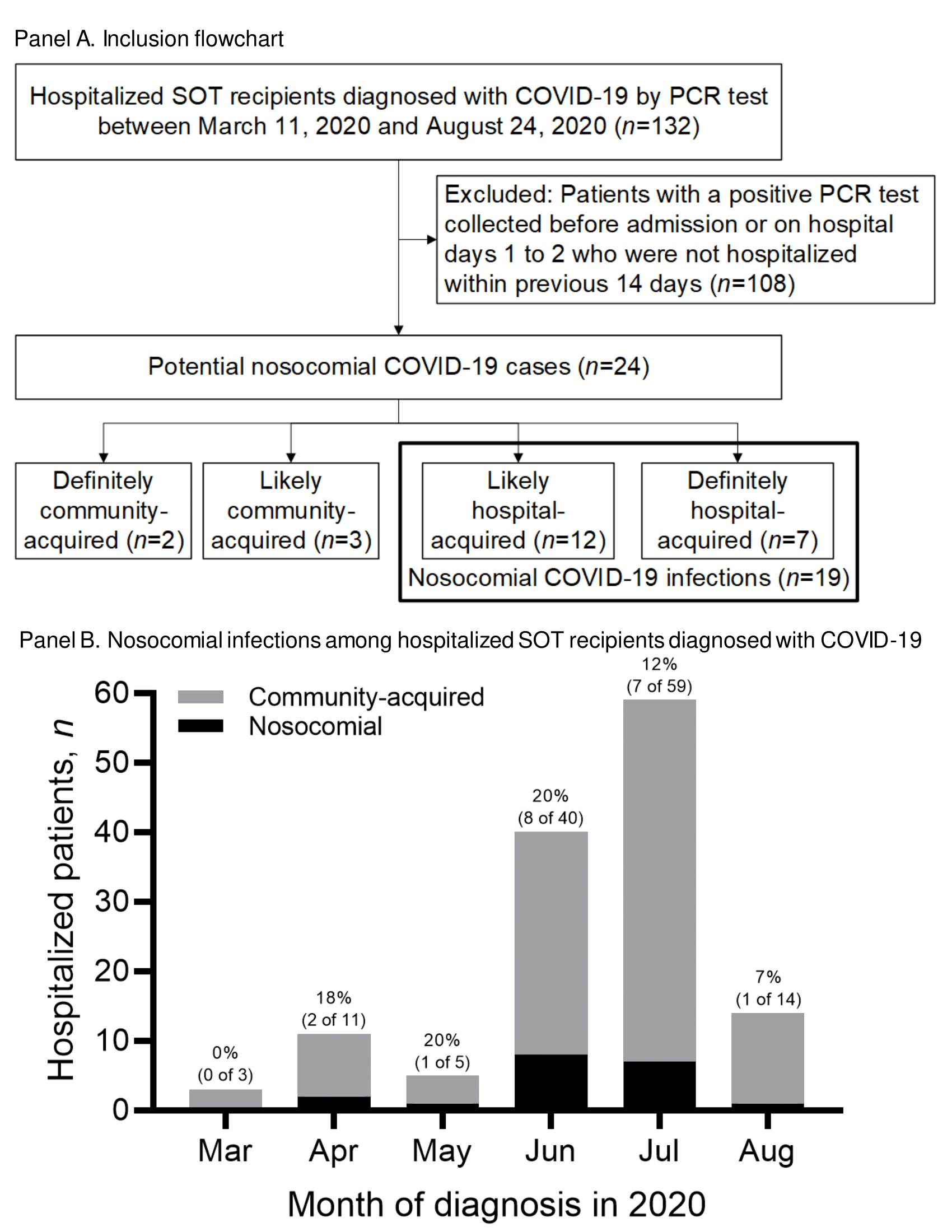Nosocomial COVID-19 Among Hospitalized Solid Organ Transplant Recipients
J. T. Swan1, A. Tran1, E. Rizk2, E. A. Graviss1, A. Drews2, K. A. Grimes2, D. T. Nguyen1, S. G. Yi2, R. R. McMillan2, F. Yuan1, I. Carrillo3, G. Book3, F. R. Zabaneh3, L. W. Moore1, A. O. Gaber2
1Houston Methodist Research Institute, Houston, TX, 2Houston Methodist Hospital, Houston, TX, 3Houston Methodist, Houston, TX
Meeting: 2021 American Transplant Congress
Abstract number: 770
Keywords: Infection, Polymerase chain reaction (PCR)
Topic: Clinical Science » Infectious Disease » All Infections (Excluding Kidney & Viral Hepatitis)
Session Information
Session Name: All Infections (Excluding Kidney & Viral Hepatitis)
Session Type: Poster Abstract
Session Date & Time: None. Available on demand.
Location: Virtual
*Purpose: This study aimed to identify probable cases of nosocomial Coronavirus Disease 2019 (COVID-19) among hospitalized solid organ transplant (SOT) recipients.
*Methods: All hospitalized SOT recipients diagnosed with COVID-19 by polymerase chain reaction (PCR) from March 11, 2020 to August 24, 2020 were evaluated. Potential nosocomial cases included admissions where the first positive PCR occurred on hospital day 3 or later (intra-admission) or within 14 days of a previous hospital discharge (inter-admission). Two infectious disease specialists independently adjudicated all potential cases into four categories (definitely community-acquired, likely community-acquired, likely hospital-acquired, and definitely hospital-acquired) using systematic chart review of symptom onset, radiographic findings, and community risk factors. Discrepancies were resolved by a third investigator.
*Results: Of 132 hospitalized SOT recipients diagnosed with COVID-19, nosocomial infections were apparent in 19 (14%; Figure 1). Intra-admission cases (n=11, 4 likely hospital-acquired and 7 definitely hospital-acquired) were diagnosed a median (IQR) of 43 (8 to 53) days after admission. Inter-admission cases (n=8, all likely hospital-acquired) had 5 (3 to 10) days of hospital care in the 14 days preceding diagnosis. The proportion of COVID-19 infections classified as nosocomial varied by time from most recent transplant until diagnosis (P<0.001) and transplant type (P<0.001; Table 1). Probable nosocomial infections peaked in June and gradually declined.
*Conclusions: Despite infection control measures to sequester SOT recipients and their nurses on dedicated transplant floors and provide patients and healthcare workers with screening, COVID-19 may have been acquired during healthcare interactions in 14% of hospitalized SOT recipients diagnosed with COVID-19. Vaccination against COVID-19 for front-line healthcare workers is important for protection of SOT recipients.
| Patients with COVID-19, n | Patients with nosocomial COVID-19, n (row %) | ||
| Transplant type | Heart only | 9 | 4 (44%) |
| Lung only | 15 | 6 (40%) | |
| History of >1 organ | 17 | 3 (18%) | |
| Liver only | 17 | 3 (18%) | |
| Kidney only | 74 | 3 (4%) | |
| Time from the last transplant to COVID-19 diagnosis | ≤ 1 year | 23 | 9 (39%) |
| > 1 year | 109 | 10 (9%) |
To cite this abstract in AMA style:
Swan JT, Tran A, Rizk E, Graviss EA, Drews A, Grimes KA, Nguyen DT, Yi SG, McMillan RR, Yuan F, Carrillo I, Book G, Zabaneh FR, Moore LW, Gaber AO. Nosocomial COVID-19 Among Hospitalized Solid Organ Transplant Recipients [abstract]. Am J Transplant. 2021; 21 (suppl 3). https://atcmeetingabstracts.com/abstract/nosocomial-covid-19-among-hospitalized-solid-organ-transplant-recipients/. Accessed December 28, 2025.« Back to 2021 American Transplant Congress

